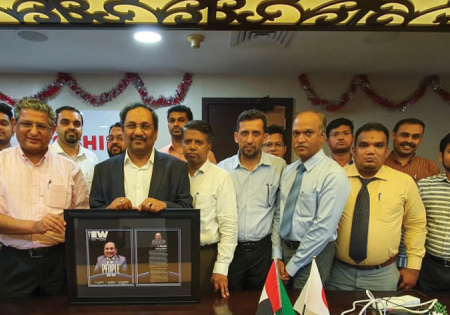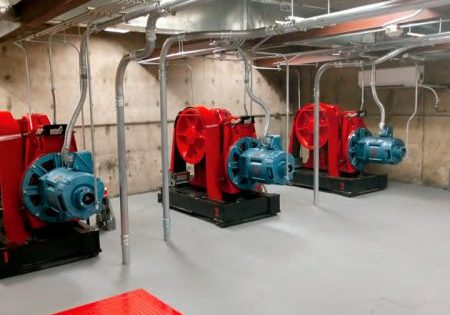Otis earnings call reveals winners, losers and opportunities.
At the midpoint of an unprecedented year, executives at Otis provided a look at what the future holds during a conference call with analysts in late July. They described an elevator world in flux and facing challenges, but not without opportunities.
Throughout the COVID-19 pandemic, they said, India remained largely in lockdown as China and — to a large extent — North America reopened and sectors of the vertical-transportation (VT) industry showed varying signs of life. During the call delving into second-quarter earnings, “solid” is how Otis CEO Judy Marks and Chief Financial Officer Rahul Ghai described the results, as they looked to continued overall improvement as 2020 winds to a close. Although it was too soon to be reflected in earnings, an increased appetite for high-tech solutions and remote monitoring is clearly evident, giving the company optimism about the future. (Otis had been scheduled to release its third-quarter earnings in late October.)
The pair provided a closer look at the factors affecting specific geographic areas (such as degree of lockdown, willingness to embrace new technology and rollout of government programs) and how unit makeup affects the business outlook in different parts of the world. They praised the entire Otis team for “proactively [containing] costs and [mitigating] the impact from COVID-19.”
In terms of what we’re seeing on buying behaviors, the orders, especially in North America in this last quarter, were down. A lot of the reason they were down is decisions were just not being made or were being delayed. When we speak to our customers, they’re optimistic and still plan on moving forward with their projects.
— Otis CEO Judy Marks
At that time, Marks estimated that roughly 90% of buildings had opened worldwide, versus only 65% in April. Restricted areas were mostly in Southeast Asia (India in particular), she said. “In North America, we are almost totally reopened,” Marks observed. “As we reopen, though, we are seeing different behaviors due to health and safety concerns.” The company has adjusted procedures and staggered workforce schedules in light of these concerns, she said.
One analyst observed that a rival OEM sees the market getting back to 2019 levels by 2022. He asked Marks and Ghai whether this is a fair assessment. In response, Marks said:
“In terms of what we’re seeing on buying behaviors, the orders, especially in North America in this last quarter, were down. A lot of the reason they were down is decisions were just not being made or were being delayed. When we speak to our customers, they’re optimistic and still plan on moving forward with their projects. Additionally, when you look at our end market exposure, we are far more than 50% driven by residential, and we’re seeing residential projects grow strongly. So, our outlook really does anticipate that we get back to strong new equipment sales sometime in 2021.” Ghai added that activity in China has been particularly strong, both in infrastructure and other sectors, with second quarter (Q2) being especially strong. Overall, though, it’s an uncertain environment and it’s going to be fluid, he said. So far, business seems to be recovering well. As [Marks] mentioned, “jobsites are coming back, and that’s what we’re focused on right now.”
Worldwide, Otis’ new-equipment orders were down in the quarter 6.8% in terms of company revenue not resulting from an acquisition. There were double-digit new-equipment revenue declines in the Americas and in Europe, the Middle East and Africa (EMEA), partially offset by new-equipment orders in China, which were up by the “high single digits.” The decline in new-equipment order sales and a low single-digit decline in service sales contributed to overall sales being down 6.5%.
Decline in demand for new equipment reflects continued challenges in accessing jobsites. New equipment demand in North America largely returned to pre-COVID levels in March, with gradual recovery in south Europe and the Middle East expected to follow later in the year.
In response to an analyst’s question, Marks explained how the southern Europe market differs from the larger EMEA region. “Southern Europe is definitely a bigger market for us: we have No. 1 positioning in France, Spain and Italy,” she said, continuing:
“Our business in Germany did really well in the second quarter, so that we are seeing. . . the Nordics, the German markets, Switzerland, come back strongly, and Southern Europe is a little bit slower, as you would expect, given what you saw happen with the pandemic.” There is reason for Otis to have optimism about EMEA and beyond, however. Marks pointed out that approximately 70% of its EMEA business is residential. “I’m convinced there is pent-up demand” for residential elevator modernization, she said. Roughly 5.5 million residential elevators worldwide are more than 20 years old and “either in need of aesthetic or technology upgrades.” The EMEA region alone, she said, is home to approximately 3 million units older than 20 years.
Residential elevators in China present modernization opportunities, as well.
The challenge, she said, will be getting customers to engage and view such upgrades as mandatory, rather than discretionary. As units age, a tipping point will happen.
Otis has what Marks described as an “intense focus” on growing its service portfolio through business growth and retention:
“The biggest move we made in the portfolio this quarter was China, which went up over 5% in terms of units under maintenance. That’s the largest-growing market in this portfolio. We’ve challenged the team to outgrow what they’ve done in the past in every region, but especially in China.”
Government regulations are fueling growth in other parts of Asia. In South Korea, a mandatory safety program is resulting in significant modernization of existing elevator stock, and the multiyear program is expected to boost revenue throughout the remainder of 2020 and into 2021.
Otis’ appetite for acquisitions remains strong, with roughly US$50 million annually budgeted for that purpose. “It’s a matter of [identifying] the right properties coming up, especially to add to our service portfolio in regions where we can achieve synergies and have the ability to integrate effectively and gain those units on the portfolio,” Marks said. “We’ve got a deal book that’s live and always looking.”
The company continues to deploy new units in the Americas, Europe and China, and expects the pace of deployment of Internet of Things (IoT) technology to pick up substantially in the latter part of 2020. Throughout the challenging times, new and innovative products continued to be rolled out, Marks and Ghai said, including:
- Touchless elevator technology such as gesture control
- Purification products
- Remote monitoring and predictive maintenance
- Elevator models such as the Gen2 Prime, targeting the low-rise market in India and other developing countries.
Customers’ appetite for leading-edge technology varies, but Otis expects it to only increase, post-COVID-19. Marks said:
China is where we’ve seen the biggest [push] to start from purification fans, and [those are] being ordered in the thousands, to touchless technologies, [such as those] using our app for an iPhone or Android to be able to call an elevator.— Marks
China is where we’ve seen the biggest [push] to start from purification fans, and [those are] being ordered in the thousands, to touchless technologies, [such as those] using our app for an iPhone or Android to be able to call an elevator.— Marks
“China is where we’ve seen the biggest [push] to start from purification fans, and [those are] being ordered in the thousands, to touchless technologies, [such as those] using our app for an iPhone or Android to be able to call an elevator. We are piloting some hand-gesturing technology, as well, as just better traffic flow. So you see early adopters following both the technology early adopter curve, but also we’re seeing it earlier in places that have recovered earlier. [What] we’re seeing on the early adopters in EMEA, the rest of the [Asia-Pacific] and the Americas, are those building managers who are really trying to figure out how not to queue in the lobbies and how to really create a safe and healthy building environment. And it’s really early, but we’re starting to see — it’s not material in terms of revenue yet — but a lot of people are interested.” Otis’ hand-gesturing technology is being piloted at Foxwoods Resort Casino, only about an hour from the OEM’s headquarters in Farmington, Connecticut. Despite the misgivings of Governor Ned Lamont, the casino reopened on June 1, and a resort spokesman said the system “provides guests with the option to safely control elevators solely through voice commands and hand gestures.”[1] He said Foxwoods is the first casino to implement this technology.
Otis Vice President of Marketing and Product Strategy Chris Smith observed touchless technology is popular among several customers in large cities in India and expects those in North America to soon follow suit.[1] All kinds of high-tech solutions are gaining momentum, Marks explained:
“IoT is going to make a significant difference. Digital adoption is going to make a significant difference. And we’re seeing customers now really having discussions with us on what can we know when from data access from a remote [Application Programming Interface] perspective. And so we see [this] — and that’s why we’re running full steam on Otis ONETM and really picking up the pace in the second half of the year to make up for the first half, where we didn’t have access to all the buildings we needed to install the sensors and the gateway to our cloud. But you’re going to see that pick up, and we’re going to hit that 100,000 units on Otis ONE throughout the globe in the countries we’ve identified by year-end. And that is going to drive service quality — absolutely.”
Reference
[1] Teehan, Sean. “Amid Heightened Hygiene Concerns, Otis Puts Focus on Touchless
Elevator Technology,” Hartford Business Journal, August 25, 2020.
Get more of Elevator World. Sign up for our free e-newsletter.









